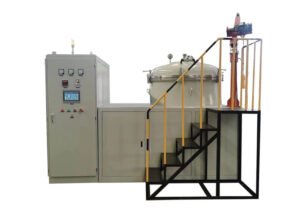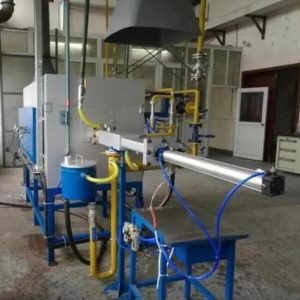Compared with the traditional sintering method, the efficiency of material preparation and the performance of the prepared material are significantly improved. This technical feature makes SPS Spark Plasma Sintering develop rapidly in the field of ceramic materials. Studies have shown that exceptionally high melting point materials with low diffusion coefficients, such as nitrides, borides, and carbides, can rapidly prepare at relatively low temperatures under SPS conditions.

CHINAEQUIPS SPS SPARK PLASMA SINTERING FURNACE
There is still a lot of controversy about the contribution of the electric field to the rapid densification of SPS Spark Plasma Sintering.
During the SPS Spark Plasma Sintering process, load the current between the upper and lower mold pressure heads so that the sample is under the condition of an electric field. So the German FCT company named this sintering method “Field Assisted Sintering Technique” (Field Assisted Sintering Technique, FAST) and commercialized worldwide. There is still a lot of controversy about the contribution of the electric field to the rapid densification of SPS. It is undeniable that the existence of an electric field has an essential effect on the internal chemical structure of the material, especially the formation and diffusion rate of defects.
Professor Munir, a well-known scholar of SPS technology, proposed in his review paper that to manifest the effect of electric field on material diffusion through the electron wind effect by increasing the concentration of point defects or by reducing the activation energy of defect diffusion. Based on the correlation between particle rearrangement and pulse voltage in SPS liquid phase sintered Si3N4, Belmont et al. proposed the sintering mechanism of “Electro-wetting theory.”
Whether there is enough electric field strength to promote the sintering of ceramic materials is the focus of debate.
Regarding the role of the electric field in the SPS process, some scholars also put forward different views. The reason is that the SPS process uses high current and low voltage for heating (take CHINAEQUPS Spark Plasma Sintering Furnace Model CNEQPS-SPS-5T5KA as an example, the maximum current is 5000 A, the maximum Voltage 10 V); whether there is enough electric field strength to promote the sintering of ceramic materials in this mode is the focus of debate.
Langer et al. compared the sintering behavior of non-conductor Al2O3, semiconductor ZnO, and ionic conductor 8YSZ under the condition of 150ºC/min and 50MPa SPS with the sintering behavior under the same pressure HP condition and found that the two were in the process of densification Mechanistically, there was no significant difference. Regarding the promoting effect of the electric field on the SPS sintering process, the research methods reported in the early stage are mostly theoretical calculation and analysis based on experimental data, and there has been a lack of more intuitive experimental results. Until recently, in the study of SPS sintered 8YSZ, Chen et al. observed that an abnormal “wavy” interface was formed in the sintered body (as shown in Figure 2). They attributed it to the “interface diffusion as The “ionic wind” effect of the medium.
It still determines whether all ceramic materials have a similar promotion effect.
In recent years, with the emergence of new sintering technologies such as flash sintering (Flash Sintering), the promotion effect of electric field on sintering has attracted widespread attention from scholars. Raj et al. pointed out that SPS can provide sufficient electric field assistance in the sintering process of YSZ materials through the circuit simulation of the mold. Recently, Grasso et al. combined SPS technology with flash sintering technology and proposed a “Flash Spark Plasma Sinter, FSPS,” successfully applied to the rapid densification of pure ZrB2 ceramics. However, most of the current contributions to the electric field in the SPS process are materials with the ionic conductor or semiconductor properties, such as YSZ, as the research objects. It still determines whether all ceramic materials have a similar promotion effect. In addition, there still needs to be effective quantitative means to characterize the contribution of the electric field to the SPS process.









